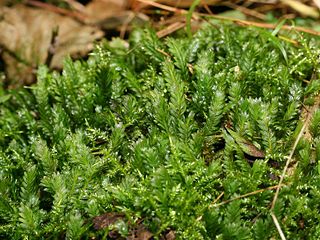
Fissidens adianthoides, the maidenhair pocketmoss, is a moss in the family Fissidentaceae. It was first collected by Hedwig in 1801.

The Ballyhoura Mountains are in south-east County Limerick and north-east County Cork in central Munster, Ireland, running east and west for about 6 miles on the borders of both counties.

Pleurozium schreberi, the red-stemmed feathermoss or Schreber's big red stem moss, is a moss with a loose growth pattern. The root name pleuro comes from the Latin for ribs, possibly describing how the parts branch from the stem.
Rhytidiadelphus triquetrus, the big shaggy-moss or rough goose neck moss, is a species of moss in the family Hylocomiaceae. It is often the dominating moss species in moderately rich forest habitats in the boreal regions and the Pacific Northwest. Because of its fuzzy appearance and tail-like shape it is also called the 'electrified cat's tail moss'. Not to be confused with square goose-necked moss, Rhytidiadelphus squarrosus.

Hypnum cupressiforme, the cypress-leaved plaitmoss or hypnum moss, is a common and widespread species of moss belonging to the genus Hypnum. It is found in all continents except Antarctica and occurs in a wide variety of habitats and climatic zones. It typically grows on tree trunks, logs, walls, rocks and other surfaces. It prefers acidic environments and is fairly tolerant of pollution. It was formerly used as a filling for pillows and mattresses; the association with sleep is the origin of the genus name Hypnum.

Bryotropha terrella is a moth of the family Gelechiidae. It is the type species of the genus Bryotropha. It is found in Europe.
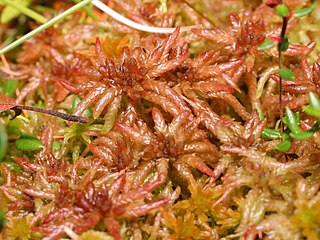
Sphagnum magellanicum, commonly called Magellanic bogmoss, Magellan's sphagnum, Magellan's peatmoss or midway peat moss, is a widespread species of moss found in wet boreal forest in the far south and southwest of South America, North America and Eurasia.
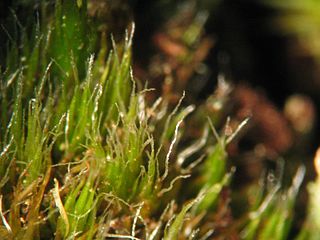
Campylopus introflexus, also known as the heath star moss, is a species of moss. The first description of the species was made by Johannes Hedwig as Dicranum introflexum in 1801.

Rhytidiadelphus squarrosus is a species of moss known as springy turf-moss in the United Kingdom, and square goose neck moss in the United States. It is widespread in Eurasia and North America, and has been introduced to the Southern Hemisphere. It has broad ecological tolerances, and is usually found in man-made habitats such as lawns and golf courses. It is most closely related to R. subpinnatus, with which it is often confused.
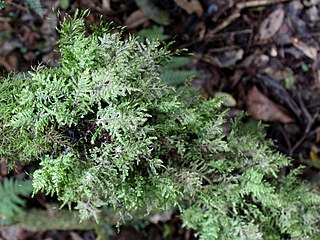
Eurhynchium praelongum is a species of moss with a widespread distribution. Found in Australia, New Zealand, North America, northern South America, Eurasia and North Africa .

Moss lawns are lawns composed of moss, which occur naturally, but can also be cultivated like grass lawns. They are a defining element in moss gardens.

Warnstorfia fluitans, the floating hook-moss or water hook-moss, is a species of moss found in acidic habitats across all continents except Antarctica.
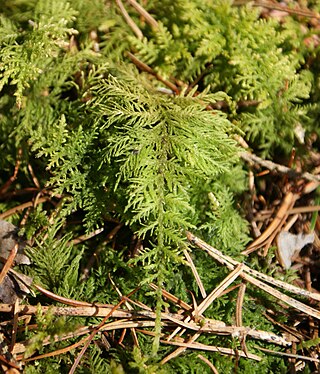
Thuidium tamariscinum is a species of moss belonging to the family Thuidiaceae. It has an almost cosmopolitan distribution.

Sphagnum contortum is a species of moss reported in North America and Europe. NatureServe marked its global conservation status as Secure.
Sphagnum denticulatum is a species of moss belonging to the family Sphagnaceae. It is widely distributed in Europe but it is also found in other parts of the world.
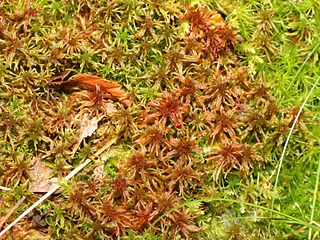
Sphagnum warnstorfii is a species of moss belonging to the family Sphagnaceae. It is widely distributed in the north hemisphere.

Philonotis seriata is a species of moss belonging to the family Bartramiaceae. It is widely distributed in Europe but it is also found in other parts of the world.
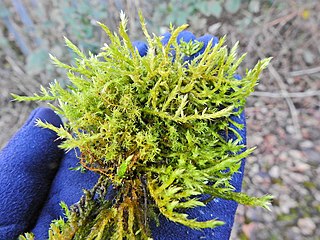
Calliergonella cuspidata is a species of moss belonging to the family Pylaisiaceae. It is widely distributed around the world.
















